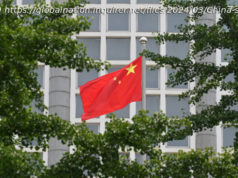The Chinese yuan will likely end the year at 6.95 to the U. S. dollar, according to the median of 31 forecasts in a CNBC survey.
China’s leadership is prepared to let the country’s currency weaken to support its exporters as global trade tensions deepen, experts told CNBC.
But, they said, Beijing will prevent any disorderly depreciation in the dollar/yuan exchange rate beyond 7, a politically sensitive level upon which Washington may seize to label China a currency manipulator.
On Thursday afternoon, the yuan was at about the 6.84 level to the dollar.
Beijing’s currency policy stands at a crossroads this month. The outlook for the yuan ultimately hinges on whether the U. S. administration makes good on its threats to slap tariffs on an additional $200 billion worth of Chinese imports.
“In a scenario where there is an immediate lift in tariffs, say closer to 20 percent rather than 10 percent along with threats of more to come, then we suspect the 7 CNY barrier is more likely than not to be breached,” said Rodrigo Catril, senior currency strategist at National Australia Bank, referring to a common shorthand for the yuan. “For now we are leaning towards the softer scenario which allows for CNY to trade sub 7.”
The currency fell for 11 straight weeks to Aug. 24, a record losing streak reflecting looser monetary policy, patchy progress on U. S.-China trade talks and a broadly outperforming U. S. dollar.
Concerned about outflows to developed markets, Beijing reintroduced measures to stabilize its managed currency, including a calculation method called the counter-cyclical factor (CCF) that’s aimed at keeping the yuan’s daily midpoint fixed to a relatively stable value. Put simply, the strategy appears aimed at defending the currency from attack by market speculators.
“Underlying pressure points on the yuan — weaker growth and US-China trade tensions — appear likely to worsen,” said Teck Leng Tan, director and foreign exchange analyst at UBS CIO Wealth Management. “Chinese policymakers, too, have shown more tolerance of yuan declines, in line with the broader [foreign exchange] market. Curbing speculation, rather than outright depreciation, appears to be the real objective of the CCF tool.”
UBS’ Tan added: “We cannot rule out a significant rise past seven yuan to the dollar if trade tensions escalate or if Chinese economic data worsens in the months ahead.”
The Chinese yuan will likely end the year at 6.95 to the U. S. dollar, according to the median of 31 forecasts in a CNBC survey compiled in August and updated to take account of the reintroduction of the stability measures in late August by the People’s Bank of China, the country’s central bank.
“It’s harder for [the dollar/yuan rate] to slide beyond 7.0 in a sustained manner given that there is more in the Chinese authorities’ policy toolkit should the need arise to further contain CNY depreciation pressures,” said Bank of Singapore currency strategist Sim Moh Siong.
Still, Sim said it was possible for the currency to “briefly blip” above 7 against the dollar under a bear case scenario where U. S. President Donald Trump “swiftly gives the green light to implement the second round of tariffs on $200 billion imports from China in one tranche and set a path for an additional $200 billion.”
Within the CNBC survey, Dariusz Kowalczyk, senior emerging markets strategist at Credit Agricole, and Patrick Perret-Green, strategist at AdMacro, offered the predictions of the strongest yuan at 6.65 to the dollar. The forecast for the weakest Chinese currency came from Jonathan Pain, author and publisher of The Weekly Pain Report, at 7.25 for every dollar.
China faces scrutiny from Washington not only on perceived trade imbalances but also its currency policy. Trump in an interview with Reuters last month said China and the European Union “absolutely” manipulated their currencies.
The U. S. Treasury publishes its next semi-annual report on foreign currency practices in October. Though China wasn’t named as a currency manipulator in the April report, it remained on the Treasury’s “monitoring list” of countries with questionable foreign exchange policies.
The U. S. dollar/yuan exchange rate “may well be capped around current levels just above 6.80, ahead of the October half-year review of FX practices by the U. S. Treasury,” said Koon How Heng, head of markets strategy at UOB. “But the bias for the medium term remains that of [yuan] weakness as long as there is no clear resolution of U. S.-China trade conflict.”
Beijing is keen to avoid the manipulator label, which may be “self-reinforcing” and would serve to fuel an even more hawkish U. S. trade policy, said ING economist Rob Carnell. Further depreciation in the yuan, he said, “would be a red rag to the U. S. president and bring about currency manipulation charges, and further tariffs… but if you can manage your currency, and the Chinese certainly can, I don’t see what they have to gain by allowing it to slide like that.”






